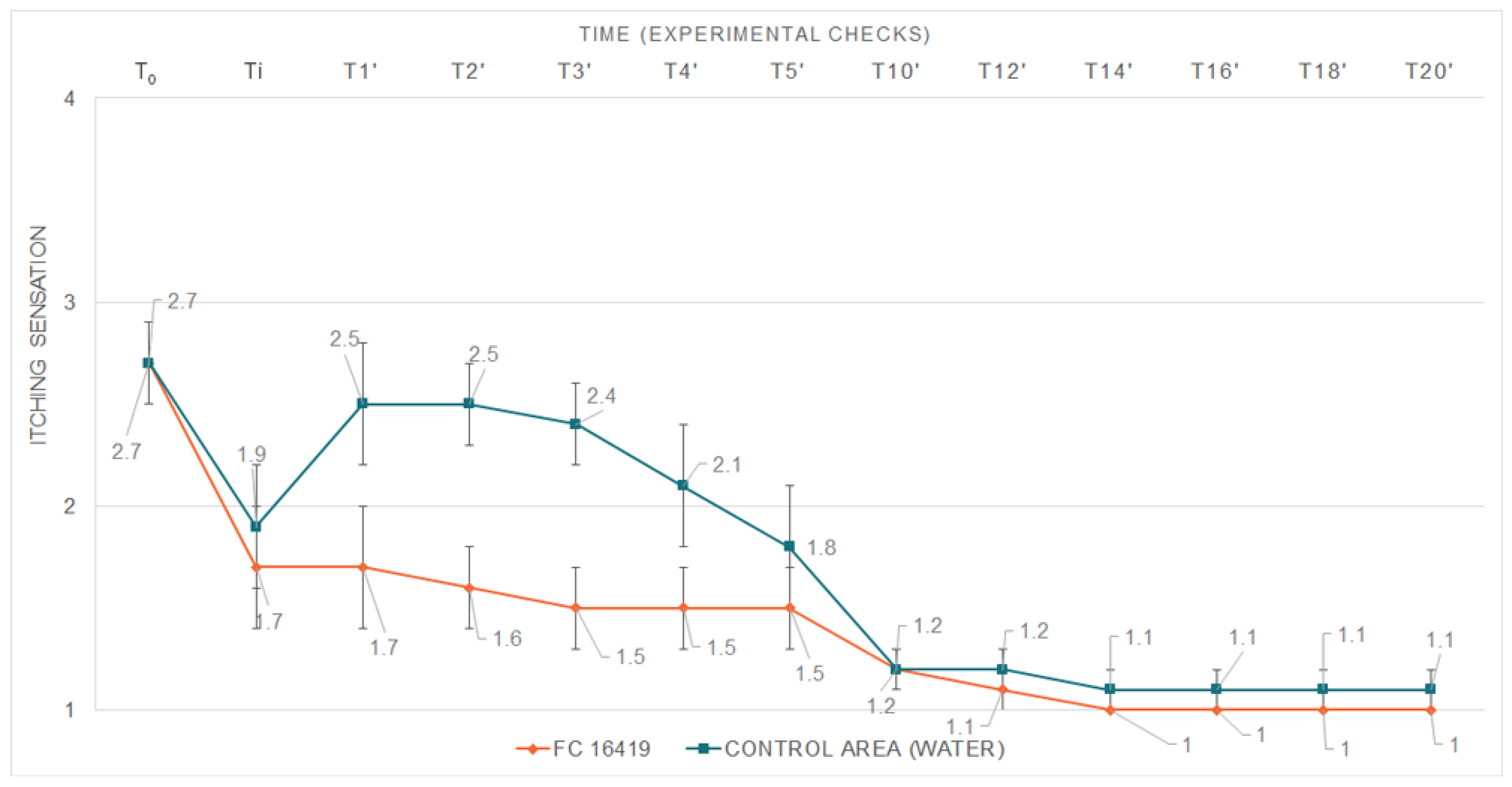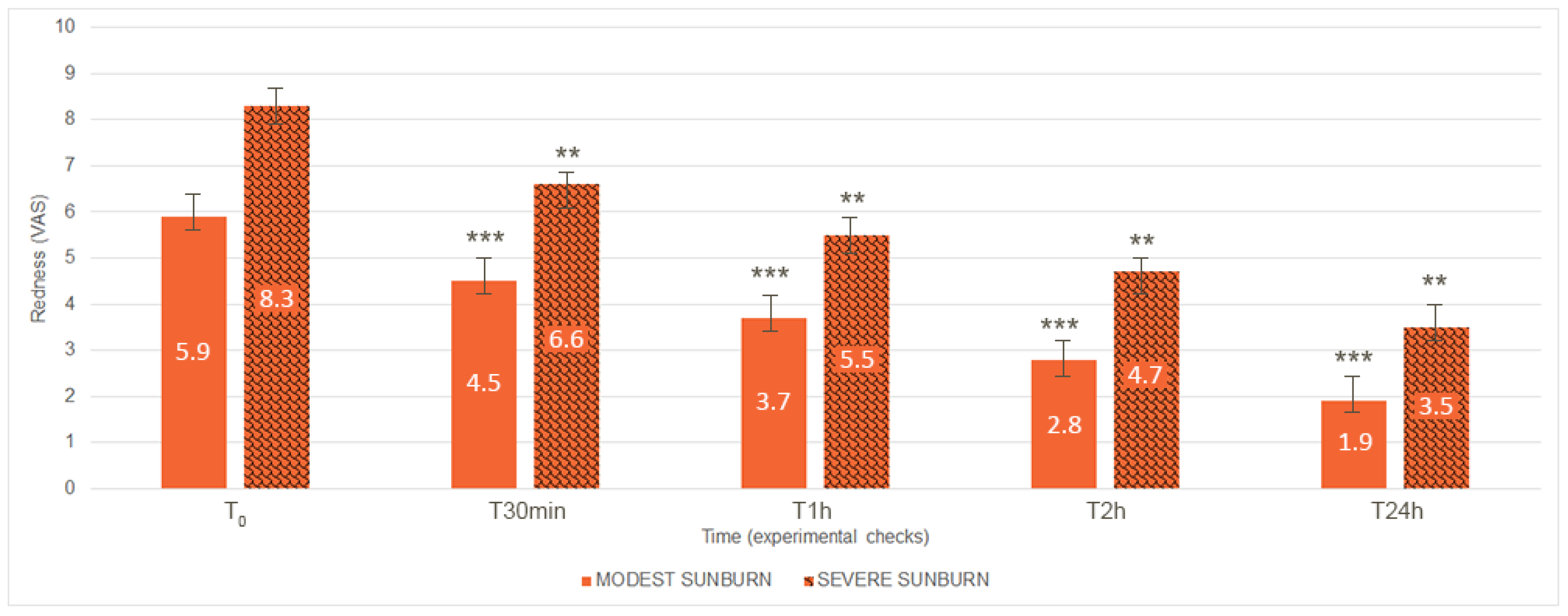Soothing Effect of a Cosmetic Product on Skin Discomforts Induced by a Chemical Irritant (Capsaicin) and UV-Radiation, and after Mosquito Bites and Sunburn in a Real-World Setting
Abstract
1. Introduction
1.1. Skin Barrier
1.2. Dry Skin and Itching
1.3. Pathophysiology of Sunburn
1.4. Pathophysiology of Insect Bites and Stings
1.5. Use of Natural Products for Soothing Irritated Skin
2. Materials and Methods
2.1. Formulation Approach and Actives Selection
2.1.1. Formulation Approach
2.1.2. Active Ingredients Selection
2.2. Experimental Design and Participants
2.2.1. Assessment of the Soothing Effect of a Cosmetic Product on Skin Discomforts Induced by a Chemical Irritant (Capsaicin)
- (A)
- Application of 10% capsaicin aqueous solution
- (B)
- T0—Timepoint of maximum stinging/itch sensation (approximately 2/3 min after application of capsaicin solution)
- (C)
- Application of FC 16419/demineralized water on right/left nasolabial fold
- (D)
- Ti—Intensity of perceived discomfort (stinging/itch) immediately after the first products application
- T1′—Intensity of stinging/itch 1 min after products application
- T2′—Intensity of stinging/itch 2 min after products application
- T3′—Intensity of stinging/itch 3 min after products application
- T4′—Intensity of stinging/itch 4 min after products application
- T5′—Intensity stinging/itch 5 min after products application
- T10′—Intensity of stinging/itch 10 min after products application
2.2.2. Clinical Evaluation of the Soothing Effect of a Cosmetic Product on Skin Irradiated by a Solar Simulator (UVA+B)
2.2.3. Test of Use Aimed to Evaluate the Soothing Efficacy of the Cosmetic Product after Accidental Mosquito Bites and Sunburn
2.3. Statistics
3. Results
3.1. Soothing Effect of a Cosmetic Product on Skin Discomforts Induced by a Chemical Irritant (Capsaicin)
3.1.1. Clinical Scoring of the Stinging Sensation (20/20 Participants)
3.1.2. Clinical Scoring of the Itching Sensation (11/20 Participants)
3.2. Soothing Effect of the Cosmetic Product on Skin Irradiated by a Solar Simulator (UVA+B)
3.3. Test of Use of the Cosmetic Product after Mosquito Bites and Sunburn
3.4. Safety Evaluation
4. Discussion
4.1. Soothing Effect on the Capsaicin-Induced Itching and Stinging Sensation
4.2. Soothing Effect on UV-Induced Erythema
4.3. Real-World Data Replicating Effects on UV-Induced Redness and Itching after Insect Bites
5. Conclusions
Author Contributions
Funding
Institutional Review Board Statement
Informed Consent Statement
Data Availability Statement
Acknowledgments
Conflicts of Interest
References
- Nicolaou, A.; Pilkington, S.M.; Rhodes, L.E. Ultraviolet-radiation induced skin inflammation: Dissecting the role of bioactive lipids. Chem. Phys. Lipids 2011, 164, 535–543. [Google Scholar] [CrossRef] [PubMed]
- Vaughn, A.R.; Clark, A.K.; Sivamani, R.K.; Shi, V.Y. Natural Oils for Skin-Barrier Repair: Ancient Compounds Now Backed by Modern Science. Am. J. Clin. Derm. 2018, 19, 103–117. [Google Scholar] [CrossRef] [PubMed]
- Ständer, S.; Zeidler, C.; Augustin, M.; Bayer, G.; Kremer, A.E.; Legat, F.J.; Maisel, P.; Mettang, T.; Metz, M.; Nast, A.; et al. S2k-Leitlinie zur Diagnostik und Therapie des Chronischen Pruritus. 2022 (Article in German). Available online: https://www.awmf.org/leitlinien/detail/ll/013-048.html (accessed on 6 June 2022).
- Weisshaar, E.; Szepietowski, J.; Dalgard, F.; Garcovich, S.; Gieler, U.; Giménez-Arnau, A.; Lambert, J.; Leslie, T.; Mettang, T.; Misery, L.; et al. European S2k Guideline on Chronic Pruritus. Acta Derm.-Venereol. 2019, 99, 469–506. [Google Scholar] [CrossRef] [PubMed]
- Lin, T.-K.; Zhong, L.; Santiago, J.L. Anti-Inflammatory and Skin Barrier Repair Effects of Topical Application of Some Plant Oils. Int. J. Mol. Sci. 2017, 19, 70. [Google Scholar] [CrossRef]
- Yosipovitch, G.; Misery, L.; Proksch, E.; Metz, M.; Ständer, S.; Schmelz, M. Skin Barrier Damage and Itch: Review of Mechanisms, Topical Management and Future Directions. Acta Derm.-Venereol. 2019, 99, 1201–1209. [Google Scholar] [CrossRef] [PubMed]
- Loden, M. The clinical benefit of moisturizers. J. Eur. Acad. Derm. Venereol. 2005, 19, 672–688. [Google Scholar] [CrossRef]
- Gendrisch, F.; Esser, P.R.; Schempp, C.M.; Wölfle, U. Luteolin as a modulator of skin aging and inflammation. BioFactors 2021, 47, 170–180. [Google Scholar] [CrossRef]
- Liu, Z.; Fluhr, J.; Song, S.; Sun, Z.; Wang, H.; Shi, Y.; Elias, P.; Man, M.-Q. Sun-Induced Changes in Stratum Corneum Function Are Gender and Dose Dependent in a Chinese Population. Ski. Pharmacol. Physiol. 2010, 23, 313–319. [Google Scholar] [CrossRef]
- Jiang, S.J.; Chu, A.W.; Lu, Z.F.; Pan, M.H.; Che, D.F.; Zhou, X.J. Ultraviolet B-induced alterations of the skin barrier and epidermal calcium gradient. Exp. Dermatol. 2007, 16, 985–992. [Google Scholar] [CrossRef]
- Frödin, T.; Molin, L.; Skogh, M. Effects of single doses of UVA, UVB, and UVC on skin blood flow, water content, and barrier function measured by laser-Doppler flowmetry, optothermal infrared spectrometry, and evaporimetry. Photo-Dermatology 1988, 5, 187–195. [Google Scholar]
- Skin Cancer Foundation, Sunburn & Your Skin. Available online: https://www.skincancer.org/risk-factors/sunburn/ (accessed on 6 June 2022).
- Russell, K.; Jacob, S.E. Bisabolol. Dermatitis 2010, 21, 57–58. [Google Scholar] [CrossRef] [PubMed]
- Thomsen, J.S.; Sonne, M.; Benfeldt, E.; Jensen, S.B.; Serup, J.; Menne, T. Experimental itch in sodium lauryl sulphate-inflamed and normal skin in humans: A randomized, double-blind, placebo-controlled study of histamine and other inducers of itch. Br. J. Derm. 2002, 146, 792–800. [Google Scholar] [CrossRef] [PubMed]
- Simone, D.A.; Ngeow, J.Y.F.; Whitehouse, J.; Becerra-Cabal, L.; Putterman, G.J.; LaMotte, R.H. The Magnitude and Duration of Itch Produced by Intracutaneous Injections of Histamine. Somatosens. Res. 1987, 5, 81–92. [Google Scholar] [CrossRef] [PubMed]
- Fostini, A.C.; Golpanian, R.S.; Rosen, J.D.; Xue, R.-D.; Yosipovitch, G. Beat the bite: Pathophysiology and management of itch in mosquito bites. Itch 2019, 4, e19. [Google Scholar] [CrossRef]
- Engler, R.J.; Crisp, H.C. Mosquito hypersensitivity: Clinical updates. In Stinging Insect Allergy: A Clinician’s Guide, 1st ed.; Freeman, T.M., Tracy, J.M., Eds.; Springer: Cham, Switzerland, 2017; pp. 203–230. [Google Scholar]
- Insect Bites and Stings: First Aid, Majo Clinic. 2018. Available online: https://www.mayoclinic.org/first-aid/first-aid-insect-bites/basics/art-20056593 (accessed on 5 October 2021).
- National Institute for Health and Care Excellence [NICE]. Insect Bites and Stings. 2021. Available online: https://cks.nice.org.uk/topics/insect-bites-stings/ (accessed on 14 June 2021).
- Rinaldi, G. The Itch-Scratch Cycle: A Review of the Mechanisms. Derm. Pract. Concept. 2019, 9, 90–97. [Google Scholar] [CrossRef]
- Fruhstorfer, H.; Hermanns, M.; Latzke, L. The effects of thermal stimulation on clinical and experimental itch. Pain 1986, 24, 259–269. [Google Scholar] [CrossRef]
- Tips to Prevent and Treat Bug Bites. American Academy of Dermatology Association [AADA]. 2021. Available online: https://www.aad.org/public/everyday-care/injured-skin/bites/prevent-treat-bug-bites (accessed on 5 October 2021).
- Hernandez, R.G.; Cohen, B.A. Insect Bite–Induced Hypersensitivity and the SCRATCH Principles: A New Approach to Papular Urticaria. Pediatrics 2006, 118, e189–e196. [Google Scholar] [CrossRef]
- Millington, G.W.M.; Collins, A.; Lovell, C.R.; Leslie, T.A.; Yong, A.S.W.; Morgan, J.D.; Ajithkumar, T.; Andrews, M.J.; Rushbook, S.M.; Coelho, R.R.; et al. British Association of Dermatologists’ guidelines for the investigation and management of generalized pruritus in adults without an underlying dermatosis, 2018. Br. J. Derm. 2018, 178, 34–60. [Google Scholar] [CrossRef]
- NICE. National Institute for Health and Care Excellence. 2021. Available online: https://cks.nice.org.uk/topics/itch-widespread/management/management-of-widespread-itch/ (accessed on 14 June 2022).
- Maranz, S.; Wiesman, Z. Influence of Climate on the Tocopherol Content of Shea Butter. J. Agric. Food Chem. 2004, 52, 2934–2937. [Google Scholar] [CrossRef]
- Cosmetic Ingredient Database (CosIng). Available online: https://ec.europa.eu/growth/tools-databases/cosing/index.cfm?fuseaction=search.details_v2&id=84401 (accessed on 5 June 2022).
- Yosipovitch, G.; Szolar, C.; Hui, X.Y.; Maibach, H. Effect of topically applied menthol on thermal, pain and itch sensations and biophysical properties of the skin. Arch. Dermatol. Res. 1996, 288, 245–248. [Google Scholar] [CrossRef]
- Sticher, O.; Heilmann, J.; Zündorf, I. Hänsel Sticher Pharmakognosie Phytopharmazie, 7th ed.; Deutscher Apotheker Verlag: Stuttgart, Germany, 2003; p. 711. [Google Scholar]
- Watson, H.R.; Hems, R.; Rowsell, D.G.; Spring, D.J. New compounds with the menthol cooling effect. J. Soc. Cosmet. Chem. 1978, 29, 185–200. [Google Scholar]
- Bromm, B.; Scharein, E.; Darsow, U.; Ring, J. Effects of menthol and cold on histamine-induced itch and skin reactions in man. Neurosci. Lett. 1995, 187, 157–160. [Google Scholar] [CrossRef] [PubMed]
- Wasner, G.; Schattschneider, J.; Binder, A.; Baron, R. Topical menthol—A human model for cold pain by activation and sensitization of C nociceptors. Brain 2004, 127, 1159–1171. [Google Scholar] [CrossRef] [PubMed]
- Cosmetic Ingredient Database (CosIng). Available online: https://ec.europa.eu/growth/tools-databases/cosing/index.cfm?fuseaction=search.details_v2&id=35228 (accessed on 5 June 2022).
- Kamatou, G.; Viljoen, A. A Review of the Application and Pharmacological Properties of α-Bisabolol and α-Bisabolol-Rich Oils. J. Am. Oil. Chem. Soc. 2010, 87, 1–7. [Google Scholar] [CrossRef]
- Cosmetic Ingredient Database (CosIng). Available online: https://ec.europa.eu/growth/tools-databases/cosing/index.cfm?fuseaction=search.details_v2&id=74499 (accessed on 5 June 2022).
- Schoelermann, A.; Jung, K.; Buck, B.; Grönniger, E.; Conzelmann, S. Comparison of skin calming effects of cosmetic products containing 4-t-butylcyclohexanol or acetyl dipeptide-1 cetyl ester on capsaicin-induced facial stinging in volunteers with sensitive skin. J. Eur. Acad. Derm. Venereol. 2016, 30, 18–20. [Google Scholar] [CrossRef]







| Clinical Scoring of Stinging/Itching Sensation | Score |
|---|---|
| No reaction | 1 |
| Mild reaction | 2 |
| Moderate reaction | 3 |
| Severe reaction | 4 |
| Experimental Times | Area 1 Control Area—Untreated Area | Area 2 Treated Area |
|---|---|---|
| T − 1 | Evaluation of MED (minimal erythemal dose) and Erythema index on volunteers’ back before UV exposure (baseline values) | |
| Exposure to a fixed dose of UVA+B radiation (calculated as 1.5 MED for each subject) | ||
| T0 | Evaluation of Erythema index on volunteers’ back 20 ± 4 h after the UV exposure | |
| Product application by the experimenter (2 mg/cm2) | ||
| T30 min * | Evaluation of Erythema index on volunteers’ back 30 min after the first product application | |
| T1 h * | Evaluation of Erythema index on volunteers’ back 1 h after the first product application | |
| T2 h * | Evaluation of Erythema index on volunteers’ back 2 h after the first product application | |
| T24 h ** | Evaluation of Erythema index on volunteers’ back 24 h after the first product application | |
| Does the Product Give a Cold Feeling? | ||||||||
|---|---|---|---|---|---|---|---|---|
| Completely Agree | Agree | Neither Agree or Disagree | Disagree | Completely Disagree | Positive Answers | Neutral Answers | Negative Answers | |
| Timmediatelyafter | 30.3% | 63.6% | 3.0% | 3.0% | 0.0% | 93.9% | 3.0% | 3.0% |
| T 15 min | 18.2% | 66.7% | 9.1% | 6.1% | 0.0% | 84.8% | 9.1% | 6.1% |
Publisher’s Note: MDPI stays neutral with regard to jurisdictional claims in published maps and institutional affiliations. |
© 2022 by the authors. Licensee MDPI, Basel, Switzerland. This article is an open access article distributed under the terms and conditions of the Creative Commons Attribution (CC BY) license (https://creativecommons.org/licenses/by/4.0/).
Share and Cite
Nobile, V.; Zanoletti, V.; Manzoni, V.; Romagnoli, S.; Cestone, E. Soothing Effect of a Cosmetic Product on Skin Discomforts Induced by a Chemical Irritant (Capsaicin) and UV-Radiation, and after Mosquito Bites and Sunburn in a Real-World Setting. Cosmetics 2022, 9, 130. https://doi.org/10.3390/cosmetics9060130
Nobile V, Zanoletti V, Manzoni V, Romagnoli S, Cestone E. Soothing Effect of a Cosmetic Product on Skin Discomforts Induced by a Chemical Irritant (Capsaicin) and UV-Radiation, and after Mosquito Bites and Sunburn in a Real-World Setting. Cosmetics. 2022; 9(6):130. https://doi.org/10.3390/cosmetics9060130
Chicago/Turabian StyleNobile, Vincenzo, Valentina Zanoletti, Viviana Manzoni, Silvia Romagnoli, and Enza Cestone. 2022. "Soothing Effect of a Cosmetic Product on Skin Discomforts Induced by a Chemical Irritant (Capsaicin) and UV-Radiation, and after Mosquito Bites and Sunburn in a Real-World Setting" Cosmetics 9, no. 6: 130. https://doi.org/10.3390/cosmetics9060130
APA StyleNobile, V., Zanoletti, V., Manzoni, V., Romagnoli, S., & Cestone, E. (2022). Soothing Effect of a Cosmetic Product on Skin Discomforts Induced by a Chemical Irritant (Capsaicin) and UV-Radiation, and after Mosquito Bites and Sunburn in a Real-World Setting. Cosmetics, 9(6), 130. https://doi.org/10.3390/cosmetics9060130







